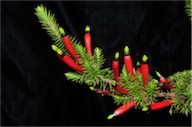In Flower This Week
A news sheet prepared by a Gardens' volunteer.
Numbers before each plant refer to temporary IFTW labels in the gardens.
Numbers in square brackets [ ] refer to garden bed Sections. Plants in flower are in bold type.
View past issues of 'In Flower This Week'.
8 July 2015
Astroloma foliosum click for larger image |
Today we will walk along the Main Path.
- On your right, in a pot, is Astroloma foliosum [Section 174]. Commonly known as Candle Cranberry, it is a small shrub species endemic to the Perth region in Western Australia. This plant has very fine foliage and upright red “firecracker” tubular flowers with black and yellow tips.
- Cross the bridge and skirt past the café to see on the left Banksia ‘Stumpy Gold’ [Section 131], with fine, toothed linear foliage and short gold cones. This plant is a dwarf cultivar of Banksia spinulosa var. collina that was selected by Richard Anderson of Merricks Nursery in Victoria from material collected on the New South Wales Central Coast.
- Also on your left is Eucalyptus gregsoniana [Section 131], a mallee (multi-stemmed tree) with grey trunks and white fluffy flowers. Also known as the Wolgan Snow Gum, it is found in the highlands of New South Wales.
- On your right is Acacia alata var. biglandulosa [Section 240], or Winged Wattle. It has flattened phyllodes (modified leaf-stems) and masses of white fluffy ball flowers and is native to Western Australia.
- On your left is Banksia spinulosa var. collina [Section 131], with fine linear foliage and slender, dull gold cones. This shrub, commonly known as Hill Banksia or Golden Candlesticks, grows along the east coast of Queensland and New South Wales.
- Go up the hill, bear right and on your left is Banksia ericifolia subsp. ericifolia [Section 30], a long-flowering medium-sized shrub with attractive feathery foliage and long orange cones. It is native to New South Wales, but has naturalised in small numbers in Victoria.
- Also on the left in a pot is Grevillea saccata [Section 30], with terminal clusters of reddish-orange flowers. Each flower has a prominent yellow tip that houses the anthers. Grevillea saccata is commonly known as Pouched Grevillea, and is a shrub endemic to southwestern Western Australia.
- Also on the left and behind the pot is Grevillea diminuta [Section 30], with dark green foliage and rusty red clusters of flowers. It is native to New South Wales and the Australian Capital Territory
- On your right is Grevillea acropogon [Section 30], a low bush with green foliage and deep red flower-clusters. It is endemic to southwestern Western Australia and is threatened in the wild.
- On your left is Adenanthos cygnorum [Section 30], a small bush with grey-green silky foliage and red spidery flowers. This plant is endemic to southwestern Western Australia.
- Also on your left is Banksia spinulosa var. neoanglica [Section 30], or New England Banksia, with silver-backed dark green foliage with upright yellow/gold cones. This shrub grows along the east coast of Queensland and New South Wales.
- On your right is Banksia ‘Cape Patterson Dwarf’ [Section 26], a small bush with dark green silver-backed foliage and lime-yellow cones.
- On your left is Grevillea manglesii subsp. ornithopoda [Section 24], or Birdsfoot Grevillea, a large open bush with pincushion-like white flowerheads all along the stems. It is native to Western Australia.
- Grevillea tripartita subsp. macrostylis [Section 26], on the right, is an open, rangy plant with dark green, prickly, three-lobed foliage and large single red and cream flowers with long showy red styles. It is native to southern Western Australia.
- Grevillea dielsiana [Section 26], also on your right, has intricate prickly linear foliage and large yellow/orange flowers with red styles. It is native to the area around Geraldton in Western Australia.
Rosalind Walcott
![Director of National Parks [logo]](../../../../images/dnp_90px.gif)







